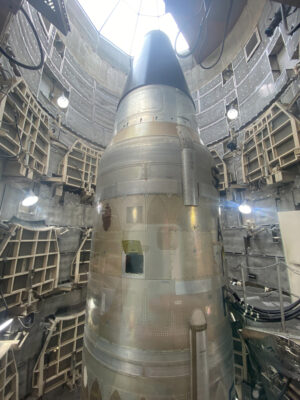By Pat Foster-Turley

There’s a lot going on underground in southern Arizona, the location of my recent road trip with my brother Ken. I did a lot of advance planning, and it really paid off big time. Some of the things we saw were unusual and provided great talking points for our time together in our rental car.
Take the Titan Missile Museum for instance. During Cold War times there were missile silos all around the United States housing these major defenses against possible attacks from overseas. This was the beginning of MAD, mutually assured destruction when, in retaliation for an enemy attack, we could slam them immediately from all corners of our country. Wow. And guess what? This strategy still reigns today. We just need to look across the St. Marys River to see part of this preparedness still happening.

Despite my uninterest in all things military, I must admit the tour of the silo, its control room, and a Titan missile itself was fascinating. After a detailed description by the tour guide about the routines of those entrusted with the missile and the safeguards and codes needed to be applied to fire it, my brother and I got a chance to act as commander and deputy commander at the control center. What a photo op. And afterward, we followed the group many more steps to see the 10-story high mothballed Titan II missile hidden from the world underground. Great that it and its cousins never got used during this period of our history.

A day later we were underground again, this time deep inside an abandoned copper mine, the Queen Mine, which marked the beginnings of the nearby town of Bisbee. For this tour, we needed to don hardhats, safety vests, and strong battery-powered lights, then straddled single seats on a train that took us into the depths. An old retired miner told us personal stories of the scary episodes he had when he worked underground, watching his colleagues have hands turned to mush, dislocated shoulders and death due to the danger surrounding this trade. “The pay was good,” he told us. ”Worth the risk,” he said. Phew.
Another site we visited was the still-running Biosphere 2 facility, originally dreamt up and fund-raised by a band of hippie actors back in the late 1980s. Although it wasn’t underground it may as well have been. The intent was to simulate life on another planet in a contained Earth-like atmosphere complete with an ocean, desert, cropland, rainforest and all the rest. Eager participants entered this structure with plans to not get out for two years, growing all their food and making studies. However, it didn’t work out as planned due to a shortage of oxygen when the microbes consumed more than expected, and negative human interactions too. Could you live enclosed with seven other people for two years with no Internet and no added resources from the world outside? I couldn’t. Neither could they. But Biosphere 2 has earned its keep. Now it is a research facility run by the University of Arizona, the source of a myriad of scientific studies about ecosystems in a time of global warming.

Although these were man-made underground conditions, I was well aware of the nature that was underground around us, too. The Sonoran and Chihuahuan deserts we visited are said to be rich in reptile life. I was eager to see Gila monsters and snakes and all the rest. Fifteen species of rattlesnakes! Wow, I couldn’t wait to see at least one, from a distance of course. But no, during the winter these reptiles are all underground, hibernating from the cold weather that winter brings to these deserts. We did get a chance to view a number of rattlesnake species safely enclosed in terrariums at the Chiricahua Desert Museum, but that wasn’t the same. And at the Sonora Desert Museum, when we visited mid-day, all the animals were invisible, hiding in the shade or underground in their large enclosures too. Better luck next time.

And there will definitely be a next time for me. This part of the country is enchanting, whatever the season, and I’ve already made plans to return. But not in summer. The reptiles may be roaming then, but the 100-plus-degree weather is a deal-breaker for me. At least this time I will visit the Arizona Sonora Desert Museum early in the morning with the hope of seeing some animals. And maybe it’s better I don’t encounter a rattlesnake after all. Caution is not my middle name.
Pat Foster-Turley, Ph.D., is a zoologist on Amelia Island. She welcomes your nature questions and observations. [email protected]
